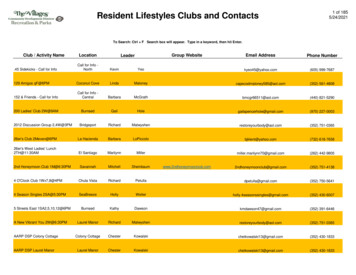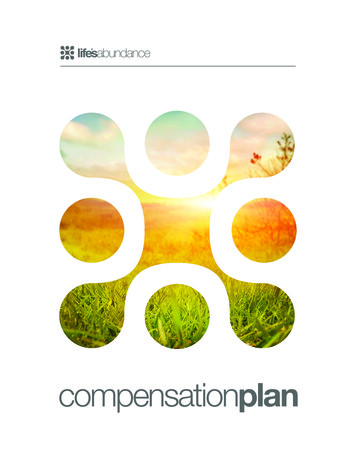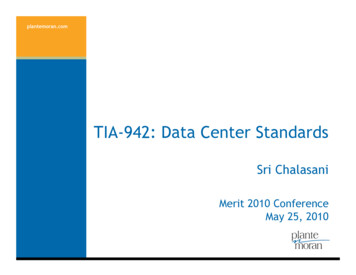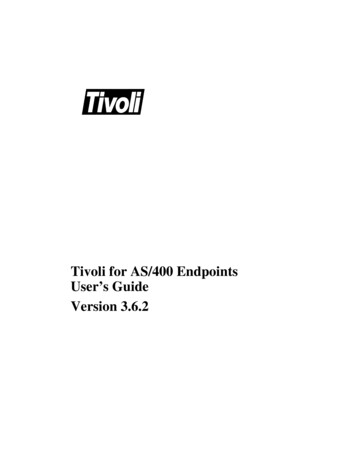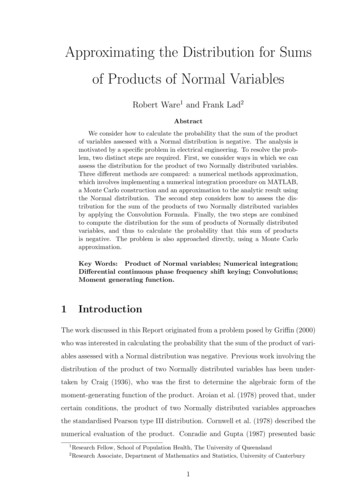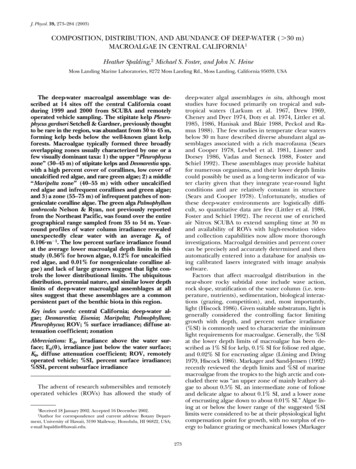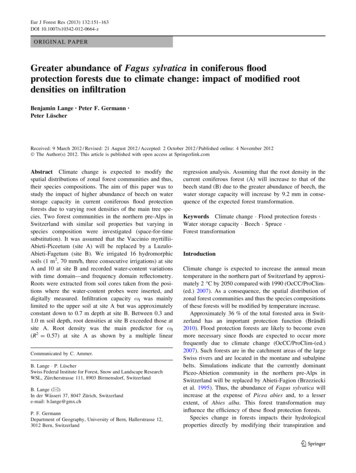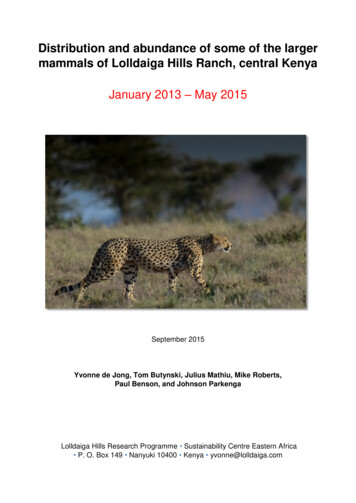
Transcription
Distribution and abundance of some of the largermammals of Lolldaiga Hills Ranch, central KenyaJanuary 2013 – May 2015September 2015Yvonne de Jong, Tom Butynski, Julius Mathiu, Mike Roberts,Paul Benson, and Johnson ParkengaLolldaiga Hills Research Programme Sustainability Centre Eastern Africa P. O. Box 149 Nanyuki 10400 Kenya yvonne@lolldaiga.com
ContentsIntroduction3Globally Threatened Larger Mammalson Lolldaiga Hills Ranch3Critical Habitat for Maintaining the LargerMammal Fauna on Lolldaiga Hills Ranch3Species Accounts and Distribution MapsMount Kenya guereza monkeyEastern patas monkeyHilgert’s vervet monkeyKolb’s monkeyAfrican wild dogBat-eared foxAfrican clawless otterCheetahGrévy’s zebraBushpigCommon warthogReticulated giraffeGreater kudu567891011121314151617SuniSteenbokGünther’s dik-dikThomson’s gazelleGerenukMountain reedbuckCommon waterbuckKlipspringerLelwel hartebeestBeisa oryxStriped ground squirrelUnstriped ground squirrel30303031313132323233Spotted hyaenaWhite-tailed mongooseAfrican buffaloBushbuckCommon elandCommon duikerBright’s gazelleImpalaAfrican savanna hare181920212223242526272829Species AccountsSouthern tree hyraxBush hyraxRock hyraxSavanna elephantOlive baboonSide-striped jackalBlack-backed jackalLionLeopardStriped hyaena3333343434353535362
IntroductionUnderstanding the distribution, abundance, and habit requirements of a species is basic to establishing abaseline for its long-term monitoring at a particular site. Since the Lolldaiga Hills Research Programme wasestablished in July 2013, we have spent thousands of hours moving about the Lolldaiga Hills Ranch ofcentral Kenya, while noting the presence and numbers of the Ranch’s larger species of mammal (i.e., speciesfor which adults attain a body weight of 3 kg). The information obtained by these, mostly opportunistic,encounters is supplemented by tens of thousands of camera trap images, as well as by a few species-focusedstudies (i.e., wild dog and cheetah).Here we present preliminary information on the distribution, abundance, and habitat requirements for 42 ofthe 54 larger mammals that are known to occur on Lolldaiga Hills Ranch, as well as for two smallermammals (i.e., unstriped ground squirrel and striped ground squirrel). The full list of mammals known tooccur on Lolldaiga Hills Ranch can be viewed on iversity/species-list/ . For many of the species, particularly the more secretive and crypticspecies, our understanding of distribution is poor and our estimate of abundance is but an informed guess.Still, this information is deemed useful, particularly when viewed against any future large increases or largedeclines in a species’ distribution or abundance on the Ranch.We have compiled distribution maps for 25 of the 44 species that we report on here. Eleven of the 19species for which no map is provided are so widespread on the Ranch that a map would be of little use.These are: savanna elephant, olive baboon, African savanna hare, leopard, lion, spotted hyaena, strippedhyaena, plains zebra, African buffalo, common eland and impala, all of which use 80% of the Ranch.Globally Threatened Larger Mammals on Lolldaiga Hills RanchAccording to the 2015 IUCN Red List of Threatened Species (www.iucnredlist.org), five of the largermammals in Lolldaiga Hills Ranch are globally threatened with extinction: Endangered: African wild dog, Grévy’s zebraVulnerable: savanna elephant, lion, cheetahIn addition, there are two subspecies of larger mammals on the Ranch that are globally threatened withextinction: Endangered: Lelwel hartebeestVulnerable: Chanler’s mountain reedbuckAs such, these species are of particular conservation concern internationally, nationally, and for the Ranch.It should be noted that the Ranch’s populations of African wild dog, savanna elephant, lion, and cheetahappear to be healthy and may be at or near carrying capacity. In contrast, the Ranch’s populations ofGrévy’s zebra, Lelwel hartebeest, and Chanler’s mountain reedbuck are small, in decline, and in danger ofbeing extirpated. These three species require particular attention as concerns their management on theRanch.Critical Habitat for Maintaining the Larger Mammal Fauna on Lolldaiga Hills RanchThe biologically richest habitat on Lolldaiga Hills Ranch is the riverine forest along the Timau River (whichforms the southern boundary of the Ranch). Covering an area of 2 km², this habitat is under threat from3
fire and unsustainable, illegal, use. There are a large number of plant and animal species that, on the Ranch,are confined to the riverine forest. For the larger mammals, these include southern tree hyrax, Kolb’smonkey, and African clawless otter. In addition, this is the primary habitat on the Ranch for guerezamonkey, bushpig, and probably suni. Loss of this riverine forest would be a big blow to the Ranch’sbiodiversity and conservation value. As such, protection of the riverine forest should be a priority for theRanch, with habitat management focused on expanding the area of riverine forest and rehabilitating the moreseverely degraded areas.Adult black-backed jackals (Canis mesomelas) at Lolldaiga Hills Ranch. Photograph by Paul Benson.Distribution maps prepared by the Lolldaiga Hills Research Programme; Yvonne de Jong, Tom Butynski,Julius Mathiu, Mike Roberts, Paul Benson, and Johnson Parkenga. Some locality records, and all of thecamera trap photographs, presented in this report were obtained through the Lolldaiga Hills InstantWildCamera Trapping Project, implemented by ZSL/EDGE/LHRP. Some locality records presented on thecheetah and African wild dog map were obtained by the Kenya Rangelands Wild Dog and Cheetah Project.Cover photograph: Adult cheetah (Acinonyx jubatus) at Lolldaiga Hills Ranch, Laikipia, central Kenya.Photograph by Paul Benson, pjbphotos.co.ukPhotographs by Yvonne de Jong, Tom Butynski, Paul Benson and Mike Roberts.All species maps and accounts available from www.lolldaiga.com 4
Mount Kenya guereza monkey (Colobus guereza kikuyuensis)Altitude range: 1900 – 2200 mMain habitats: Riverine forest and tall, dense, cedar and olive forestPercentage of Lolldaiga used: ca. 1%Group size: 3 – 10Abundance as of May 2015: 100 – 150 individualsOther information: Group of three at Three Dams. Otherwise, only along theTimau River in Kianugu Forest on southern boundary of Lolldaiga. Much more widespread in centralLolldaiga highlands during 1990s. Loss of tall cedar and olive forest to fire may be the primary cause of thispopulation decline.5
Eastern patas monkey (Erythrocebus patas pyrrhonotus)Altitude range: 1700 – 1900 mMain habitats: Whistling thorn Acacia drepanolobium open woodland.Percentage of Lolldaiga used: 5 – 10%Group size: 1 – 3Abundance as of May 2015: 4 individualsOther information: No individuals resident on Lolldaiga. Group residentduring late 1990s no longer present. Solitary adult males sometimes present, as is a group of about threeindividuals which comes onto Lolldaiga from the east. This species appears to be in decline throughoutLaikipia County.6
Hilgert’s vervet monkey (Chlorocebus pygerythrus hilgerti)Altitude range: 1700 – 2100 mMain habitats: Yellow fever Acacia xanthophloea woodland along SinyaiLugga, Timau River and larger dams.Percentage of Lolldaiga used: 5 – 10%Group size: 7 – 30Abundance as of May 2015: 200 – 300 individualsOther information: Elephant numbers on Lolldaiga are high ( 300 individuals) andincreasing. Elephants are now causing considerable damage to the yellow fever tree woodlands. This isexpected to result in a decline in Lolldaiga’s population of vervets.7
Kolb’s monkey (Cercopithecus mitis kolbi)Altitude range: 1900 mMain habitats: Riverine forestPercentage of Lolldaiga used: ca. 1%Group size: 10 – 25Abundance as of May 2015: 150 – 200 individualsOther information: Confined to riverine forest along the Timau River in thesoutheast corner of Lolldaiga (Kianugu Forest). Area occupied is likely 2 km².8
African wild dog (Lycaon pictus)Altitude range: 1700 – 2200 mMain habitats: All of the more open habitats, including open woodland onrocky hillsides.Percentage of Lolldaiga used: 70 – 85%Group size: 7 – 23Abundance as of May 2015: No fewer than three packs (35 – 45 individuals)use Lolldaiga but, with their large home ranges (700 km²), no pack is resident.Other information: Globally ‘Endangered’ species. Some locality records presented here were obtained bythe Kenya Rangelands Wild Dog and Cheetah Project.9
Bat-eared fox (Otocyon megalotis)Altitude range: 1700 – 1900 mMain habitats: Short grass with an abundance of termite mounds on relativelyflat ground.Percentage of Lolldaiga used: 15 – 25%Group size: 1 – 7 (family groups comprised of parents with off-spring).Abundance as of May 2015: 25 – 35 individuals.Other information: At least four breeding pairs on Lolldaiga in 2014. Restricted to the northern 40% ofLolldaiga.10
African clawless otter (Aonyx capensis)Altitude range: 1900 mMain habitats: Water and water-edge vegetation.Percentage of Lolldaiga used: ca. 1%Group size: 1 – 3Abundance as of May 2015: 3 individualsOther information: Only known for along the Timau River on south boundaryof Lolldaiga. Group of three camera trapped.11
Cheetah (Acinonyx jubatus)Altitude range: 1700 –2100 mMain habitats: Open to lightly wooded short grasslands on relatively flatground.Percentage of Lolldaiga used: 60 – 80%Group size: 1 – 3Abundance as of May 2015: No fewer than 11 cheetah use Lolldaiga but, withtheir large home ranges ( 500 km²), no individuals are resident.Other information: Globally ‘Vulnerable’ species. Some locality records presented here were obtained bythe Kenya Rangelands Wild Dog and Cheetah Project.12
Grévy’s zebra (Equus grevyi)Altitude range: 1700 – 2000 mMain habitats: Grassland, open bushlandPercentage of Lolldaiga used: 20 – 30%Group size: 1 – 2Abundance as of May 2015: 2 individualsOther information: Globally ‘Endangered’ species. Three adult males enteredLolldaiga from Ol Jogi in December 2014.13
Bushpig (Potamochoerus larvatus)Altitude range: 1900 – 2200 mMain habitats: ForestPercentage of Lolldaiga used: 10 – 20%Group size: 1 – 5Abundance as of May 2015: 75 – 150 individualsOther information: Nocturnal and extremely secretive. Difficult to assessdistribution and abundance. Most common in riverine forest along the Timau River at the southern borderof Lolldaiga.14
Common warthog (Phacochoerus africanus)Altitude range: 1700 – 2200 mMain habitats: bushland, savanna, grassland, particularly near water.Percentage of Lolldaiga used: 90 – 98%Group size: 1 – 14. Typically 2 – 6Abundance: 300 – 500 individualsOther information: Present everywhere except on the steepest ground. Thispopulation has increased substantially since early 2013.15
Reticulated giraffe (Giraffa camelopardalis reticulata)Altitude range: 1700 – 2100 mMain habitats: Woodlands, bushlands and grasslandsPercentage of Lolldaiga used: 55 – 65%Group size: 1 – 20Abundance as of May 2015: 100 – 150 individualsOther information: Avoids dry cedar-olive forest and riverine forest. Numbersappear to be increasing on Lolldaiga.16
Greater kudu (Tragelaphus strepsiceros)Altitude range: 1750 – 2200 mMain habitats: Bush-covered, rocky, hillsides.Percentage of Lolldaiga used: 10 – 15%Group size: 1 – 6Abundance as of May 2015: 15 – 25 individualsOther information: Population probably slowly increasing. Restricted to thenorthern 50% of Lolldaiga.17
Suni (Nesotragus moschatus)Altitude range: 1900 – 2100 mMain habitats: Forest with dense undergrowth.Percentage of Lolldaiga used: ca. 1%Group size: 1 – 3Abundance as of May 2015: 25 – 100 individualsOther information: This is an extremely cryptic and secretive species that isonly known from three sites on Lolldaiga. Very seldom observed. Presence at two of the three sites basedsolely on camera trap images. This must be one of Lolldaiga’s least common larger mammals.18
Steenbok (Raphicerus campestris)Altitude range: 1900 – 2100 mMain habitats: Savanna, open bushland, forest edge.Percentage of Lolldaiga used: 30 – 50%Group size: 1 – 3. Typically 1.Abundance as of May 2015: 100 – 250 individuals.Other information: Probably present a many more sites 1900 m than depictedon the map, but difficult to detect.19
Günther’s dik-dik (Madoqua guentheri)Altitude range: 1700 – 2100 mMain habitats: Bushland with little undergrowth and patches of bare ground.Percentage of Lolldaiga used: 20 – 30%Group size: 1 – 3 (family groups comprised of parents with off-spring).Abundance as of May 2015: 300 – 500 individualsOther information: Widely scattered and at low density on Lolldaiga.20
Thomson’s gazelle (Eudorcas thomsonii)Altitude range: 1700 – 1900 mMain habitats: Open, short grassland.Percentage of Lolldaiga used: 20 – 25%Group size: 1 – 20Abundance as of May 2015: 200 – 400 individualsOther information: Restricted to the short-grass plains of the North Valley.21
Gerenuk (Litocranius walleri)Altitude range: 1700 – 1800 mMain habitats: Bushland and woodland on relatively flat ground.Percentage of Lolldaiga used: 25 – 35%Group size: 1 – 8. Typically 2 – 5.Abundance as of May 2015: 25 – 35 individuals.Other information: Restricted to the northern 40% of Lolldaiga. Populationprobably slowly increasing.22
Mountain reedbuck (Redunca fulvorufula)Altitude range: 1900 – 2300 mMain habitats: Open montane grasslandsPercentage of Lolldaiga used: 10 – 20%Group size: 1 – 5Abundance as of May 2015: 25 – 50 individualsOther information: Globally ‘Vulnerable’ species. Population on Lolldaiga,and elsewhere in Laikipia County, appears to be in decline.23
Common waterbuck (Kobus ellipsiprymnus ellipsiprymnus)Altitude range: 1800 – 2200 mMain habitats: Tall grassland-woodland mosaic at the most moist sites.Percentage of Lolldaiga used: 25 – 35%Group size: 1 – 14Abundance as of May 2015: 200 – 400 individualsOther information: Main population is in the grasslands and woodlands ofLolldaiga’s central highlands.24
Klipspringer (Oreotragus oreotragus)Altitude range: 1800 – 2300 mMain habitats: Granitic inselbergs (kopjes) and steep, rocky, hillsides withbush and forest.Percentage of Lolldaiga used: 10 – 20%Group size: 1 – 3 (family groups comprised of parents and offspring)Abundance as of May 2015: 150 – 250 individualsOther information: Probably present on all of Lolldaiga’s larger inselbergs and steep, rocky,hillsides. Cryptic and easily over-looked.25
Lelwel hartebeest (Alcelaphus buselaphus lelwel)Altitude range: 1700 – 2000 mMain habitats: Open grassland with scattered bush and trees.Percentage of Lolldaiga used: 30 – 40%Group size: 1 – 16. Typically 3 – 10.Abundance as of May 2015: 25 – 30 individuals.Other information: Globally ‘Endangered’ subspecies endemic to LaikipiaCounty. Global population probably 500 individuals. Lolldaiga likely holds c. 5% of the globalpopulation. Population on Lolldaiga, and in Laikipia Country, appears to be in decline. Two main herds arepresent on Lolldaiga, one in the South Valley and one in the North Valley.26
Beisa oryx (Oryx beisa)Altitude range: 1700 – 1800 mMain habitats: Short-grass plains and open bushland on relatively flat ground.Percentage of Lolldaiga used: 25 – 35%Group size: 1 – 26. Typically 6 – 14Abundance as of May 2015: 30 – 40 individuals.Other information: Restricted to the northern 40% of Lolldaiga. Populationprobably slowly increasing.27
Striped ground squirrel (Xerus erythropus)Altitude range: 1700 – 2100 mMain habitats: Bushland and forest.Percentage of Lolldaiga used: ?Group size: Usually singletonsAbundance as of May 2015: ?Other information: Widespread at low density. Widely sympatric withunstriped ground squirrel.28
Unstriped ground squirrel (Xerus rutilus)Altitude range: 1700 – 2200 mMain habitats: BushlandPercentage of Lolldaiga used: ?Group size: Usually singletonsAbundance as of May 2015: ?Other information: Widespread at low density. Widely sympatric with stripedground squirrel.29
Southern tree hyrax (Dendrohyrax arboreus)Altitude range: 1900 mMain habitats: Riverine forest with large trees.Percentage of Lolldaiga used: c. 1%Group size: Typically solitary.Abundance as of May 2015: 200 individualsOther information: Confined to the c. 2 km² of riverine forest along the TimauRiver at the south end of the Ranch.Bush hyrax (Heterohyrax brucei)Altitude range: 1700 mMain habitats: Kopjes in bushland at low altitude.Percentage of Lolldaiga used: ?Group size: ? Often 1 – 3Abundance as of May 2015: ?Other information: Poorly-known on the Ranch. May be confined to thosekopjes present at lowest altitude.Rock hyrax (Procavia capensis)Altitude range: 1700 – 2300 mMain habitats: Kopjes and bare rock ridges in bushland and forest.Percentage of Lolldaiga used: 5 – 10%Group size: 1 – 12Abundance as of May 2015: 500 individualsOther information: Confined to rocky ground with ledge and boulders. Themost widespread and abundant hyrax on the Ranch.30
Savanna elephant (Loxodonta africana)Altitude range: 1700 – 2300 mMain habitats: All habitats.Percentage of Lolldaiga used: 99%Group size: 1 – 35Abundance as of May 2015: 300 – 350 individualsOther information: With the exception of olive baboon and leopard, this isprobably the most widespread large mammal species on the Ranch. A oncetransient population is becoming increasingly resident. The current population is likely above carryingcapacity for the Ranch–and causing considerable damage to trees and promoting the conversion of riverineforest and woodland to grassland. Damage to Ranch infrastructure is also considerable and increasing.Olive baboon (Papio anubis)Altitude range: 1700 – 2300 mMain habitats: All habitats.Percentage of Lolldaiga used: 100%Group size: 30 – 150Abundance as of May 2015: 2000 – 3000 individualsOther information: This is the Ranch’s most widespread large mammal. Thereis no part of the Ranch that olive baboons do not use including the steepestcliffs. All of the Ranch’s biggest cliffs are used as sleeping sites by this species.Side-striped jackal (Canis adustus)Altitude range: 2100 mMain habitats: Grassland and bushlandPercentage of Lolldaiga used: ?Group size: 1Abundance as of May 2015: 1 individual.Other information: Only evidence for this species is from several camera trapphotographs obtained one night of one individual near the Main House. Said tohave been much more common on the Ranch a decade or more ago.31
Black-backed jackal (Canis mesomelas)Altitude range: 1700 – 2200 mMain habitats: Grassland, bushland, woodlandPercentage of Lolldaiga used: 70%Group size: 1 – 7 (parents with off-spring)Abundance as of May 2015: 200 individualsOther information: One of the Ranch’s most abundant larger mammaliancarnivores.Lion (Panthera leo)Altitude range: 1700 – 2200 mMain habitats: Grassland, bushland, woodlandPercentage of Lolldaiga used: 85%Group size: 1 – 8Abundance as of May 2015: 18 – 24 individualsOther information: Widespread but most common in the grassland andbushland of the South Valley and North Valley. Given the large home range ofthis species, it is likely that no individuals are permanently on Lolldaiga. Roars heard during most nights.Leopard (Panthera pardus)Altitude range: 1700 – 2300 mMain habitats: All habitatsPercentage of Lolldaiga used: 99%Group size: 1 – 3Abundance as of May 2015: 25 – 30 individualsOther information: Next to olive baboon, this is probably the most widespreadspecies on the Ranch. The only sites not used by leopard are the steepestcliffs. Previous research on the Ranch, and elsewhere in Laikipia, indicates a density of about 1 adultleopard/10 km². With its rugged terrain and abundance of prey (perhaps particularly baboons and smallantelopes), this Ranch may offer near-optimal habitat for leopard.32
Striped hyaena (Hyaena hyaena)Altitude range: 1800 – 2200 mMain habitats: Grassland, bushland, woodland, dry forestPercentage of Lolldaiga used: ?Group size: Typically solitaryAbundance as of May 2015: ?Other information: Fairly widespread on the Ranch and frequently captured oncamera traps, but remains poorly-known.Spotted hyaena (Crocuta crocuta)Altitude range: 1700 – 2300 mMain habitats: Grassland, bushland, woodland, dry forestPercentage of Lolldaiga used: 95%Group size: 1 – 7Abundance as of May 2015: 150 individualsOther information: Call heard during most, if not every, night.White-tailed mongoose (Ichneumia albicauda)Altitude range: 1800 – 23000 mMain habitats: Bushland, woodland, dry forestPercentage of Lolldaiga used: 70%Group size: 1 – 2Abundance as of May 2015: 300 individualsOther information: Perhaps the most common larger carnivore on theRanch. Nocturnal. Almost all information obtained through camera trapping.33
African buffalo (Syncerus caffer)Altitude range: 1700 – 2300 mMain habitats: All habitats. Only absent from the steepest ground.Percentage of Lolldaiga used: 99%Group size: 1 – 150Abundance as of May 2015: 280 – 350 individualsOther information: Two large herds present, one of c. 75 individuals and oneof c. 130 individuals. Solitary bulls and small groups of bulls (2 – 6 individuals)present throughout the bushland, woodland, and forest.Bushbuck (Tragelaphus scriptus)Altitude range: 1800 – 2200 mMain habitats: Dense bushland, woodland, and forest.Percentage of Lolldaiga used: 60%Group size: Typically solitary or mother with one offspring.Abundance as of May 2015: 200 individualsOther information: Secretive, cryptic, and largely nocturnal. Seldom seen, butcamera traps indicate that bushbuck are widespread on Lolldaiga in the morewooded habitats.Common eland (Tragelaphus oryx)Altitude range: 1700 – 2200 mMain habitats: All habitats. Only absent from the steepest ground.Percentage of Lolldaiga used: 90 – 98%Group size: 1 – 105Abundance as of May 2015: 220 – 300 individualsOther information: Lolldaiga has one of the best populations of eland inLaikipia and, perhaps its largest herd (c. 105 individuals). This populationsappears to be increasing. Most common in the South Valley.34
Common duiker (Sylvicapra grimmia)Altitude range: 1800 – 2300 mMain habitats: Dense bushland, woodland, and forest.Percentage of Lolldaiga used: 50 – 60%Group size: Typically solitary.Abundance as of May 2015: 300 individualsOther information: Secretive, cryptic and nocturnal. Most of the informationon this species on Lolldaiga obtained from camera traps.Bright’s gazelle (Nanger notata)Altitude range: 1700 – 2100 mMain habitats: Grassland, open bushland, and open woodland.Percentage of Lolldaiga used: 60 – 70%Group size: 1 – 30Abundance as of May 2015: 400 individualsOther information: Previously referred to as ‘Grant’s gazelle Nanger granti’,but this taxon now elevated to species status as Nanger notata.Impala (Aepyceros melampus)Altitude range: 1700 – 2200 mMain habitats: Present in all habitats except closed forest and on the steepestground.Percentage of Lolldaiga used: 80 – 90%Group size: 1 – 40Abundance as of May 2015: 600 individualsOther information: Probably the most common and readily-observed antelopeon Lolldaiga.35
African savanna hare (Lepus victoriae)Altitude range: 1700 – 2100 mMain habitats: Grassland, bushland, woodland, glades in forestPercentage of Lolldaiga used: 90%Group size: Typically solitary.Abundance as of May 2015: 3000 individuals.Other information: This appears to be the only species of hare on theRanch. Widespread and common.Bat-eared fox (Otocyon megalotis) pups on Lolldaiga Hills Ranch, Laikipia, Kenya. Photograph by PaulBenson.36
White-tailed mongoose 33 African buffalo 34 Bushbuck 34 Common eland 34 Common duiker 35 Bright’s gazelle 35 Impala 35 African savanna hare 36 . 3 Introduction Understanding the distribution, abundance, and habit requirements of a species is basic to establishing a baseli
